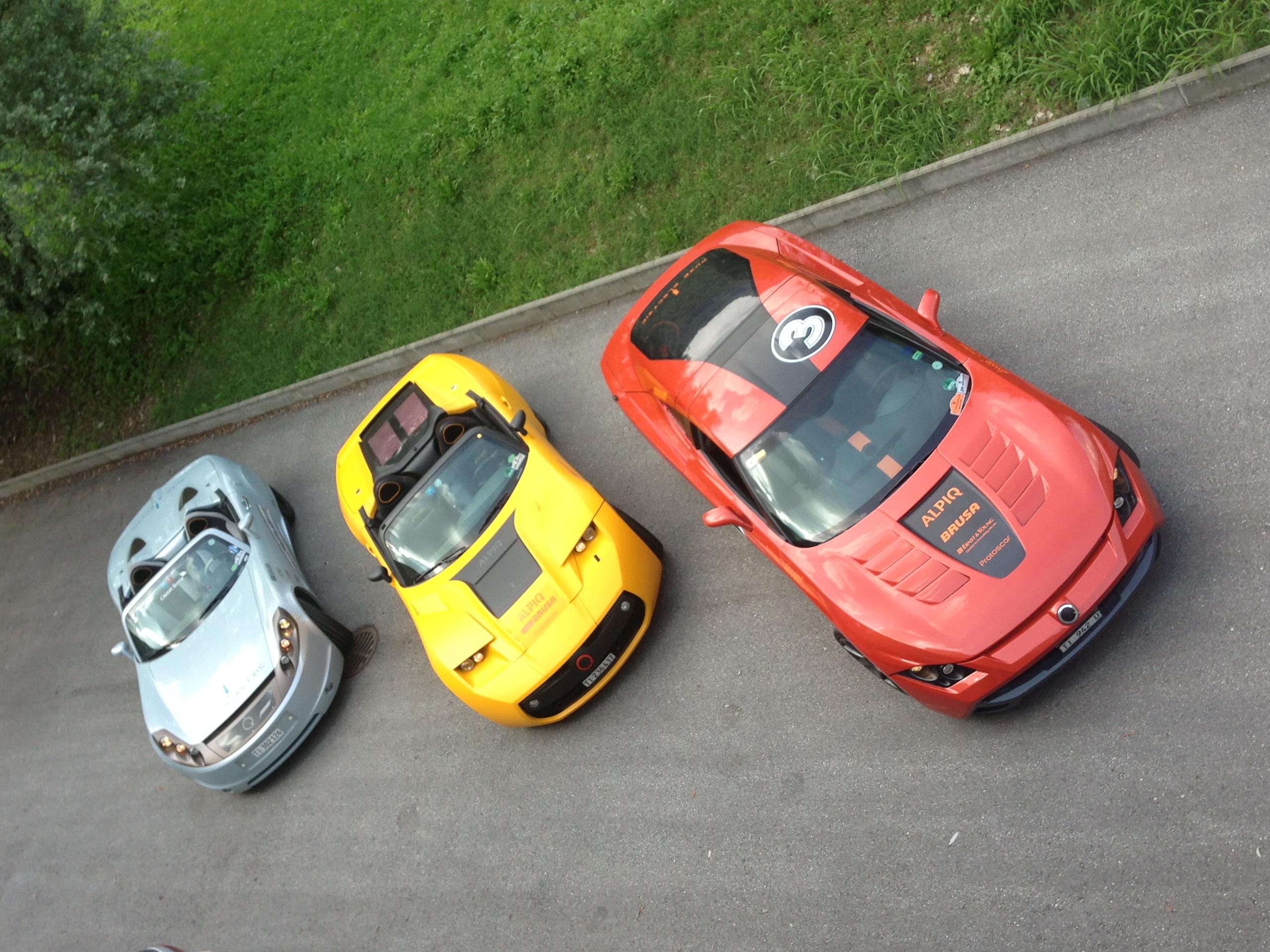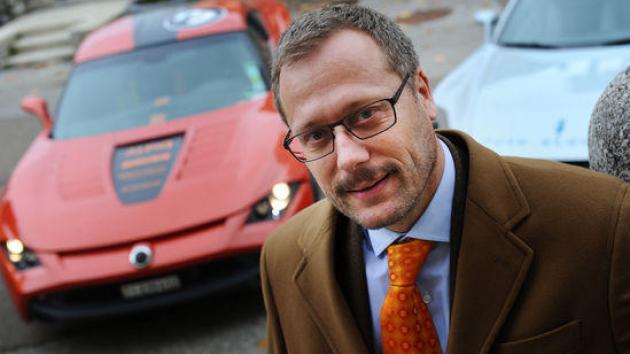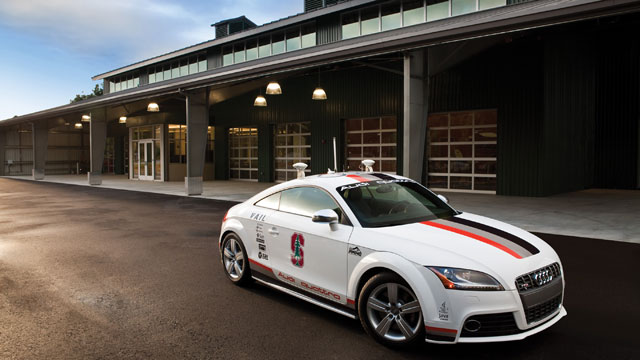Fast and futuristic, but are electric cars for everyone?

Every year battery-powered cars expand their share of the Geneva Motor Show, which opens this week. A Swiss pioneer in the field explains why he thinks half of all cars will be electric in 20 years.
Marco Piffaretti started engineering firm Protoscar at the age of 22 to develop technical and design solutions for environmentally-friendly mobility. Between 2009 and 2011, the Ticino company presented three models of the Lampo, an electric sports car that can accelerate from zero to 100 km/h in 4.5 seconds.
Geneva Motor Show
The car show was the first major international event to promote alternative propulsion technologies. At the 85th edition, which takes place from March 5 to 15, about a hundred cars will be on display with a level of efficiency that meets the new standards of the EU (emissions 0 to 95 grammes of CO2 per km). Over half these vehicles are electric or hybrid.
All major car manufacturers have developed electric cars of various kinds. In February, Apple announced that it intends to start production of an electric car in 2020. Google, meanwhile, has announced that it intends to produce an environmentally-friendly car that drives itself.
swissinfo.ch: There’s been talk of electric cars for quite some time. So, why have all the big manufacturers only started producing these vehicles in the last few years?
M.P.: The great leap forward happened in 2009, when lithium batteries started to be used in cars – they had already been used in computers and mobile telephones. This new technical solution made it possible to achieve performance that was two or three times better than what had gone before. The electric motor itself had been improved – it became lighter and more efficient – but the spurt of progress has really been made possible by the lithium batteries which now mean independent running for 100 to 400 km, depending on the model.
Thanks to this progress, electric cars today offer much better performance than a car with an internal combustion engine. Electric vehicles consume on average a quarter of the energy used by comparable vehicles powered by petrol or diesel fuel.
swissinfo.ch: You developed the Lampo, an electric car with performance comparable to that of a Ferrari or a Lamborghini. Why did you take this approach?
M.P.: In 2009, when we presented the first Lampo version at the Geneva Motor Show, the electric car was seen as suitable for an urban environment, to alleviate problems like pollution or night-time noise. With the Lampo, we wanted to show that this is really a solution for all kinds of vehicles, from trucks to sports cars. Currently, given the price of the battery, it is easier to recoup your costs if you clock up long distances. So, from a financial point of view, the electric car makes most sense as a commuter vehicle or a high-performance car. This goes some way to explain the success of the strategy now being pursued by Tesla.
The Lampo is also a kind of laboratory to experiment with the technologies we want to offer to our customers – for example, fast charging systems, which allow you to store enough power for 100 km in the space of seven minutes, and smart charging, which makes use of the options as regards photovoltaic energy and charging from the grid.
swissinfo.ch: According to some studies, by 2035 half the cars on the road will be electric. Is this a realistic goal, since these cars cost more to buy?
M.P.: Yes. I see a growing willingness at the political level to promote sustainable mobility. The EU for example has issued regulations which require car manufacturers to reduce CO2 emissions considerably – less than 95g per km by 2021. Some countries are also introducing incentives. In France the government is imposing a levy on diesel, which is to be redistributed as a €10,000 (CHF10,700) grant to anyone buying an electric car. In Norway already, the fastest-selling cars are electric. There is a major shift happening, and this goal may well be reached in some countries even before 2035.
swissinfo.ch: What about Switzerland?
M.P.: So far there has been no real federal incentives policy in favour of electric mobility. The government introduced the “Minergie” programme to promote energy savings for buildings, but there has been no equivalent for vehicles, which generate just as much in the way of CO2 emissions.
swissinfo.ch: There has been a steep drop in the price of oil – won’t that put a brake on electric mobility?
M.P.: It might be a brake temporarily, but it won’t be able to stop electric mobility. Design and development of new cars generally takes five to ten years anyway, and in this period the price of petroleum is bound to return to higher levels.

swissinfo.ch: To take off, electric mobility will need a whole new infrastructure, a network of charging stations. What stage are we at on that right now?
M.P.: So far, governments have mostly been launching initiatives to promote development of electric cars but not to build up an adequate infrastructure for charging. Yet there are more and more cities and regions thinking about how to tackle this new challenge: for example, how many charging units will be needed in the coming years, and what technical choices will have to be made? One of the main activities of our company is carrying out studies in which we identify the future need for charging infrastructure for electric cars and hybrids in cities and regions. We have already developed master plans for the cities of Zurich and Stuttgart, as well as for the cantons of Ticino and Geneva, and we expect to be able to do so for others soon, inside and outside Switzerland.

More
Geneva International Motor Show
swissinfo.ch: Why do electric cars perform better?
M.P.: The internal combustion engine, which we have been using for a century, is really a rather inefficient system, since it generates a great deal of heat that goes to waste: the exhaust gases can reach 900 degrees. A car with an internal combustion engine is really an oven on four wheels! To avoid the engine just melting, this heat is exhausted using a cooling system. In practice only a quarter of the fuel energy is used to make the car go, while the rest is burned off as heat.
The electric motor, on the other hand, gets no hotter than about 100 degrees. Almost all the energy is used to make the vehicle go. What’s more, when you brake or go downhill, the electric car recovers energy. The engine works like a dynamo and helps to keep the battery topped up.
swissinfo.ch: What are the disadvantages?
M.P.: The only big deterrent is the purchase price, currently 30% to 40% higher than internal combustion engine cars. The difference is due to the battery, which represents a full third of the cost of an electric car. The price reflects not just the materials, but also the quality of manufacture, which has to handle about ten years’ worth of vibrations and large jumps in temperature. Electric traction lets you save a lot of money in terms of running costs, but at the time of purchase it is as if you were buying a combustion-engine car with 20,000 litres of petrol in it!
Marco Piffaretti
Born in 1965 in Bellinzona, Marco Piffaretti studied automobile design at the Turin School of Applied Arts and at the Art Center College of Design in Tour de Peilz, Canton Vaud. He got hooked on sustainable mobility in 1986, when he participated as a student in the Tour de Sol, the world’s first race for vehicles using photovoltaic energy, organised in Switzerland.
In 1987 he launched Protoscar, an engineering and design company based in canton Ticino, which specialises in the development of cars using alternative propulsion and environmentally-friendly vehicles. From 1994 to 2001 he headed the VEL1 programme in Mendrisio, a project promoted by the federal government with a view to introducing 400 electric vehicles in a municipality of 10,000 inhabitants. Since 2012 he has been the director of Infovel, the competence centre for sustainable mobility of Canton Ticino.
(Translated from Italian by Terence MacNamee)

In compliance with the JTI standards
More: SWI swissinfo.ch certified by the Journalism Trust Initiative












You can find an overview of ongoing debates with our journalists here . Please join us!
If you want to start a conversation about a topic raised in this article or want to report factual errors, email us at english@swissinfo.ch.